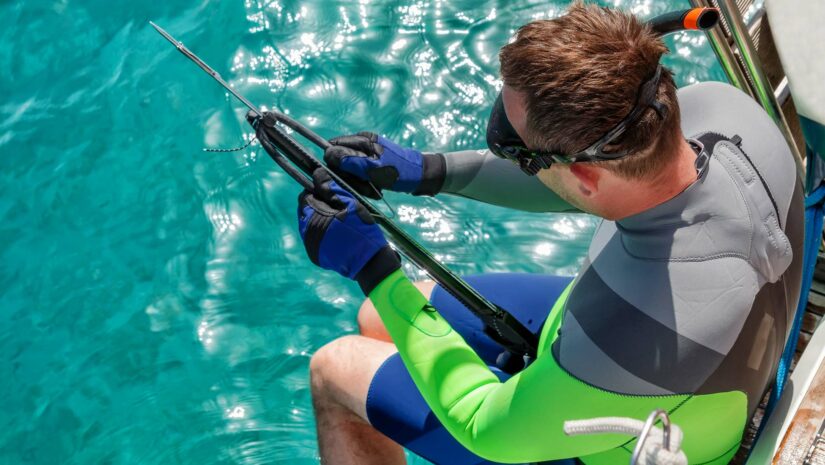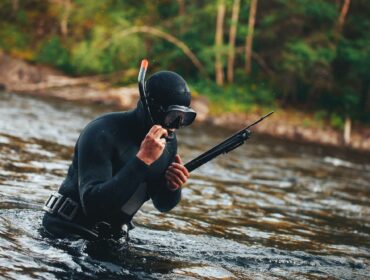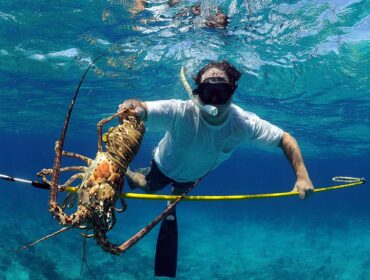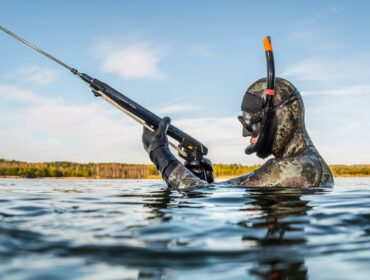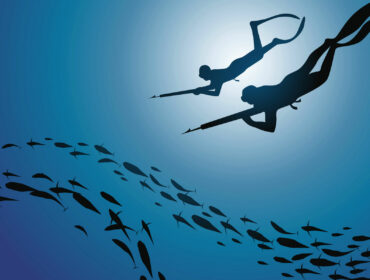Spearfishing is a unique underwater sport that is widely recognized and practiced in many parts of the world. If you’re a diver or an avid swimmer who is interested in fishing on a different, more interactive level, this sport may be for you. It’s definitely not as easy as putting on a diving suit and bringing a spear stick, but this article will guide you on your way to becoming a full-fledged spearfisher.
How to Spearfish

1. Take a Spearfishing Course
“Can’t I just get in the water and start shooting fish?”
That’s probably what you’re thinking right now—and yes, you’re absolutely right. At present, there’s nothing stopping you from doing just that, particularly if you’re already an experienced freediver and/or scuba diver. But even if you have some experience in either of the two, adding the complexities of using weapons and hunting prey makes it an entirely new ball game, so you’ll definitely want to acquire some training so you can spearfish safely and efficiently.
Most spearfishing courses are usually combined with basic freediving training, and in some cases, it’s considered a prerequisite. If you’re serious about taking up spearfishing as a hobby or a sport, it’s best to look into what training options are available in your area.
If you live in or near North Palm Beach or Destin, Florida, or in San Pedro, California, Freediving Instructors International (FII) offers a fully standardized 8-hour spearfishing program—the first of its kind in the USA—in these locations (as of writing). Developed by world-renowned spearfishers Cameron Kirkconnell, John Dornellas, and Martin Stepanek, the course teaches you all the skills you need to become a well-rounded spearo and includes instruction and education on spearfishing safety, location safety, spearfishing equipment, hunting techniques, catch management, and ethics.
2. Get a Fishing License
If you’re planning on fishing near the area where you had your diving lessons, you’ve probably already heard about their rules and regulations regarding spearfishing. In order to avoid paying rough fines for fishing where it’s not permitted, it’s best to ask the right organizations and secure your own fishing permit or license.
3. Search for Spearfishing Organizations
While you probably already have your own diving organization, it helps to find a group of divers who are experienced in freediving and spearfishing. Chances are, the diving schools and fishing organizations in your area have spearfishing clubs or charters. Vacation spots near bodies of water are also likely to have their own organizations. Spearfishing is not limited to open oceans, so you’re likely to have tons of options for underwater hunting places.
Also, look for opportunities to find out more about the basics of spearfishing. After all, it’s not just about hunting fish. There’s a lot to learn about the gear, the different types of fish, the bodies of water you’ll be hunting in, and various tips and tricks to help you catch more (and larger) fish.

4. Find a Mentor or Spearfishing Buddy
You’ll definitely need guidance during your first few spearfishing trips, so it’s best to find a fellow “spearo” or underwater hunter to hunt with. Make sure your spearfishing buddy has a lot more experience than you do so he or she can provide professional advice and help keep you safe. If you’re unable to find one, you can at least join a small spearfishing club—you should be able to find one in your area.
What’s important is that you find ways to learn more about how you can be good—and then better—at spearfishing.
5. Plan Your First Mission
For starters, it’s probably best to hunt in areas that your fellow spearos have hunted in before so they can tell you what to expect. They can brief you about the kinds of fish typically found in that area, which ones are safe to hunt and eat, the specific types of spearfishing gear you’ll need for that particular area, possible dangers (like sharks), and more.
Once you’ve gathered all the details you need, you can move on to the next crucial step.
6. Gather the Right Gear
Now, the fun part—shopping for your spearfishing equipment. They pretty much consist of the same stuff you use for snorkeling and/or diving, except now you’ll need hunting gear. Ask your spearfishing buddies and do your own research to find out exactly what you’ll need.
To give you an idea, the speargun you’ll need for low-visibility areas and for hunting small reef fish would only be around 75cm to 100cm, but it’s perfectly okay to start off with one that’s just 55cm short. A single-band speargun will suffice for small to medium-sized fish.
Once you’ve gained more experience and would like to hunt bigger game fish or try your luck in deeper waters, you’ll need a longer multi-band gun or an air-powered (pneumatic) speargun.
If you’re a total spearfishing beginner, you may need a basic spear stick for practice, but feel free to look and shop around for a good entry-level speargun. To help you narrow down your choices, check out our article where we discuss the best spearguns on the market for spearos of different skill levels.

7. Practice in Shallow Waters
In order for you to be more comfortable with spearfishing, you’ll first need to practice using the proper spearfishing technique in shallow waters, where you won’t have to worry about the dangers of underwater diving and using your speargun just yet.
With proper attire on and a pole spear in hand, first practice the “stalking” technique where you stay above water and hunt fish that are just below the surface. You can be standing in the water or on the rocks, as long as you can swiftly pierce fish from where you are. After a few tries, you’ll begin to understand the different behaviors of different types of fish.
Once you’ve gotten the hang of spearfishing above the surface, you can try submerging yourself (with a snorkel) and spearfishing below the surface. You can also choose to test out your speargun in slightly deeper bodies of water like ponds and shallow lakes.
8. Get to Know Your Weapon
When you think you’re ready to use a speargun, make sure to familiarize yourself with the basics of how to load, aim, and shoot the weapon before you go out into the water. This is essential if you want to operate efficiently underwater and enjoy a safe experience during your first attempt at spearfishing.
There are different types of weapons used in spearfishing. There are pole spears, Hawaiian slings, and band or pneumatic spearguns. The first (pole spear) is pretty straightforward, but the others will definitely require some knowledge of how to operate the weapon—loading, rigging, aiming, and firing—to ensure safe handling.
If you’re using a band speargun, here are some videos that may help you learn more about how to operate your weapon:
9. Perfect Your Aim
The aiming technique differs from diver to diver. For some, it’s as simple as pointing and shooting. Others have a specific technique that works for them, like aiming along the side of the gun for better control over the vertical axis. Practice sighting and aiming, and use whatever method works best for you and your weapon of choice.
Another piece of advice: always aim for the head. Release the safety lock of your speargun, point your gun at your prey, stabilize yourself, and then pull the trigger to release the spear shaft in one swift movement.
Remember—it’s not enough to just harm the fish. You’ll probably want to catch as many fish as you can, and that can be pretty difficult to achieve if the ones you’ve already caught are struggling and trying to free themselves.
To avoid making the fish suffer and having to puncture it a second time with your hand knife, make sure you get close enough and have good aim before pulling that trigger.

10. Practice Freedive Spearfishing
Spearfishing can be done while either freediving or on scuba, but keep in mind that scuba spearfishing is often prohibited in certain parts of the world. Therefore, if you plan on spearfishing outside of the country, it helps to learn how to do it while freediving.
Keep in mind that freedive spearfishing entails higher risks (specifically of drowning) than scuba. However, as long as you stick to shallow waters—at least until you become more experienced—and take all the necessary precautions to keep yourself safe, you should be good to go.
11. Store Your Catch Properly
When you were spearfishing above water, it may have been easy to store them in a bucket beside you. But when spearfishing in deeper waters, you’ll have to get used to hooking them to your fish carrier so you can continue hunting for more. You can use a bag or a stringer, although the latter is not advisable in waters that see a lot of shark activity as you can end up attracting them to you.
Don’t forget to wear gloves to keep your hands safe from sharp spines and fins.
12. Set Diving Boundaries
The key to a safe spearfishing mission, aside from having a spearfishing buddy, is following standard safety guidelines and setting boundaries that you can easily follow. Before diving, talk to your buddy about the radius of the dive, your dive direction, and how long you’ll be underwater. These will help ensure that you won’t end up losing or accidentally hitting each other.
And there you go—a comprehensive guide on how to get started with spearfishing. We hope this helps you out. Good luck!
Also, if you’re a more experienced spearo, share your own tips below!

